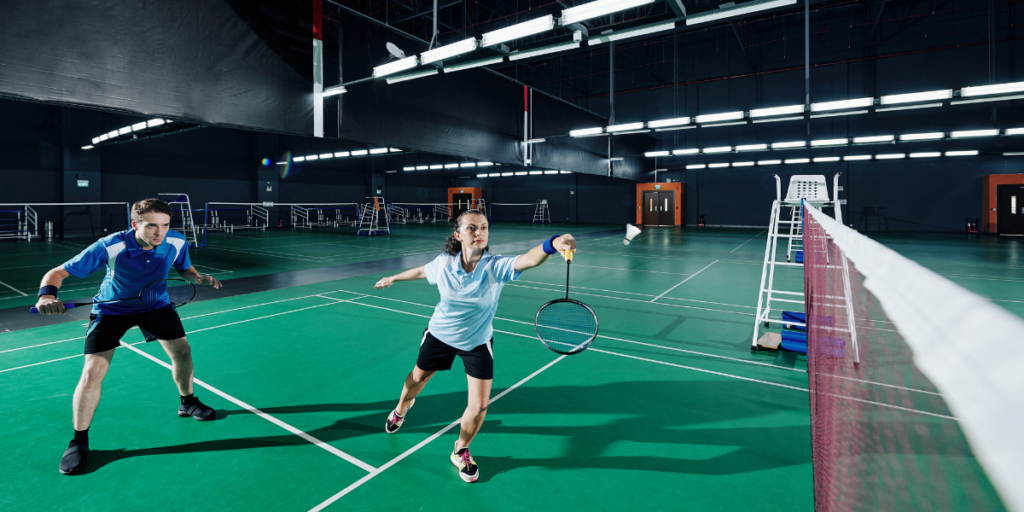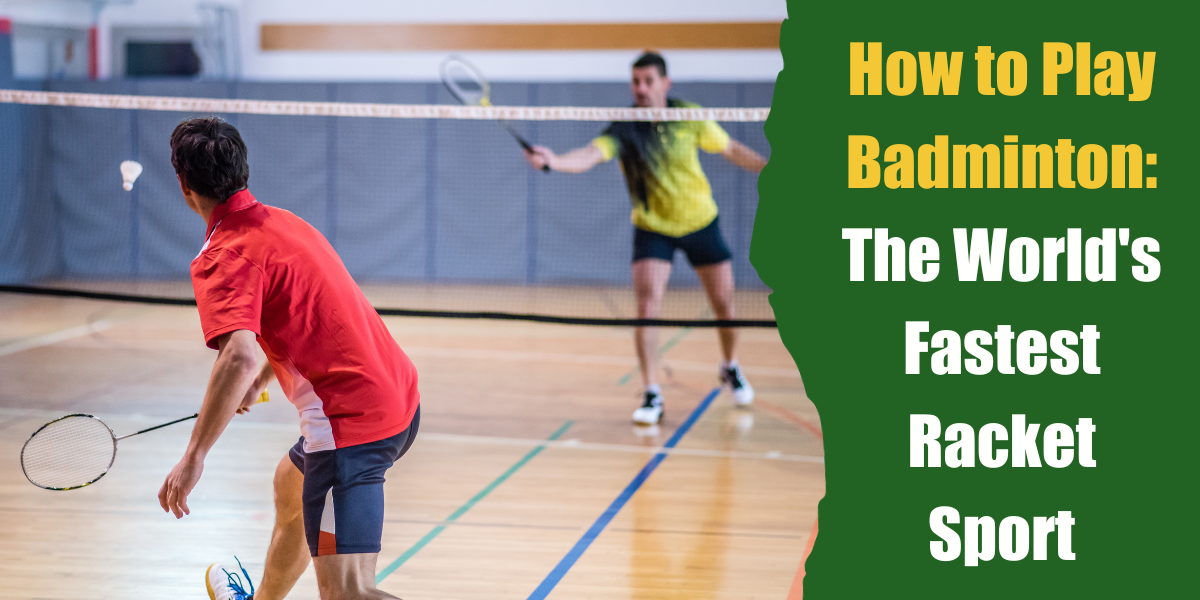Do you wish there was a sport that had all the fast-paced, reflex-testing action of volleyball and tennis, but placed less of an emphasis on raw power?
Then look no further than badminton, the fastest-paced racket sport in the world.
It’s no wonder why this Olympic sport is one of the most popular recreational activities on beaches and rec centers around the world.
In fact, the only sport that’s played by more people than badminton is soccer.
Here’s a full rundown on how to play badminton so you’re ready for the next match.
HOW TO PLAY BADMINTON? THE BASICS

Badminton is a game for two or four players. It is played using a net, one badminton racket for every player, and a small, lightweight projectile called a birdie or shuttlecock.
A shuttlecock can be made of cork with a feathered tail, or else made of rubber with a plastic tail.
A match between two players is called a singles match, a match between two teams of two players each is called a doubles match, and a mixed doubles match is played with one man and one woman on each team.
A badminton court is 44’ long, with a 17’ width for singles matches, and a 20’ width for doubles. The net should be placed five feet off of the ground across the entire width of the court.
The basic objective of badminton is to hit the birdie back and forth across the net without letting it touch the ground inside your zone.
One of these back-and-forth sessions is called a “rally”.
If the birdie touches the ground in your opponent’s zone, you are said to have “won” that rally and are awarded one point.
To win badminton game, a player must be at least two points ahead of his or her opponent, and have a minimum of 21 points in total. To win a match, a player or team must win a best two out of three series of games.
If players become tied at 20 points, play continues until someone achieves a two point lead or is the first to reach 30, whichever comes first.
>>Learn about different ways to play another one of our favorites: Ping-Pong
GETTING STARTED
To begin, toss a coin to decide which player or team gets to go first. The winner of the coin toss gets to decide which side of the court they would like to play on, and whether they would prefer to serve first or let their opponents serve to them.
In badminton, all serves must be underhanded. That means that contact must be made with the birdie no higher than the bottom of the server’s rib cage.
Both sides of the court are divided into two areas called service courts. When you are serving, you want to aim to the service court diagonal from you.
When the game is starting or the server’s score is even, both the server and their opponent stand in the right-hand service court. When the server’s score is odd, players start from the left.
During the serving phase, any contact between the server’s racket and the birdie counts as a serve, even if it’s unintentional. Once the rally begins in earnest, players can leave the right or left hand service zones as needed.
FAULTS, FOULS, ERRORS, & LETS
Faults, also known as errors or fouls, are a term used to indicate a rule has been broken, resulting in an end to the current rally and a point for the opposing player or team.
Faults include:
- Hitting the birdie out of bounds. Note that in a lined court, a birdie landing directly on the line is still considered in bounds.
- Hitting the birdie so that it gets stuck in the net or otherwise doesn’t clear it. If the birdie strikes the net but passes over anyway, it is not considered a fault.
- Hitting the birdie after it touches the ground. A birdie cannot be returned if it bounces; as soon as the birdie hits the ground the rally is ended.
- Physical contact with the birdie, either with your body or your clothing.
- Deliberately distracting or otherwise impeding your opponent’s ability to play.
- Hitting the birdie while it is on your opponent’s side of the net.
- Hitting the birdie twice in a row.
- Hitting the birdie when it is already out of bounds.
A “let” is a term used to indicate some kind of interruption to the game that is no one’s fault. In the case of a let, no one loses any points, and the serve does not pass from one player or team to the other. Instead, the point is replayed entirely.
Lets include:
- Both players faulting simultaneously during a serve.
- Sudden inclement weather.
- A birdie falling apart.
- An outside person or object entering the court.
- It is too difficult to discern whether the birdie landed in or out.
- The server serving before the receiver was ready.
SHOTS & STROKES
In badminton, a ‘stroke’ is the term used for the different ways you can swing your racket. There are four main types of stroke:
- Overhead Forehand: the most common stroke, and the most basic to execute. A simple forward swinging motion from above the waist.
- Underarm Forehand: Hitting the birdie with the front of the racket below your waist. Generally used to return drop shots.
- Overhead Backhand: A difficult type of stroke for many to master, the overhead backhand requires you to turn your back to your opponent momentarily.
- Underarm Backhand: Easier to execute than the overhead backhand, this is a good way to return a low shot with added power.
The term ‘shot’, on the other hand, refers to the way the birdie is aimed with the stroke. All shots are executed by using one of the four main types of stroke.
- Clear Shot: Also known as a lob shot, this defensive play sends the birdie high over the net towards the back of the opponent’s court. The purpose of this shot is to buy yourself time to get back into a comfortable position.
- Drop: The aim of a drop shot is to send the birdie just barely over the net, so that it drops in the opponent’s zone as close to the net as possible. This is especially effective when your opponent is out of position.
- Drive: A quick and direct shot aimed close over the top of the net, a drive is often aimed directly at the opponent’s body, hoping to force a fault
- Smash: A downward angled shot, the smash is the faster, deadlier cousin of the drop shot. Smashes are effective, but only possible when the birdie is sufficiently high in the air.
- Net Shot: Returning the birdie close to the net often forces your opponent to use a high clear shot, setting you up for a smash
- Net Kill: Often used to return higher than intended net shots, a net kill is essentially the net shot version of a smash, intended to finish the rally and earn a point
- Net Lift: Intended to move play further away from the net, the Net Lift is often used to return net shots.
One game of badminton is often all it takes to turn people into lifelong fans.
The beauty of badminton is that it can be enjoyed by players of all skill levels and dedications, so whether you’re looking for a casual pick-up game at the beach or you’re a serious athlete looking to put your reaction time to the ultimate test, pick up a couple of rackets, a birdie, and a net, and get started!


